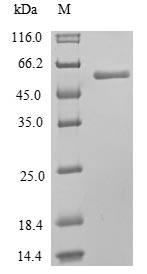The full-length cDNA ORF of Human Mixed lineage kinase domain-like protein (MLKL) was N-terminally tagged a 6xHis and then expressed in E.coli. The Recombinant Human MLKL obtained got over 85% of purity determined by SDS-PAGE. Under reducing conditions, the MLKL protein migrated to an approximately 59 kDa molecular mass band on the gel. And stored MLKL proteins are offered. This recombinant MLKL protein may find uses in the specific antibody synthesis or the studies of MLKL-related signal transduction.
MLKL is the terminal executor of necroptosis. In addition to the necroptotic function, MLKL is also involved in diverse biological processes. It controls the degradation of the myelin sheath, subsequently facilitating nerve regeneration. Studies have shown that MLKL controls NLRP3 inflammasome formation and IL-1β release in macrophages upon TLR activation. Moreover, MLKL is also involved in the maintenance of the integrity of cellular membrane & the promotion of cell survival, the regulation of the expression of endothelial adhesion molecules, the control endothelial cell (EC)-leukocyte interaction in vitro and in vivo.






